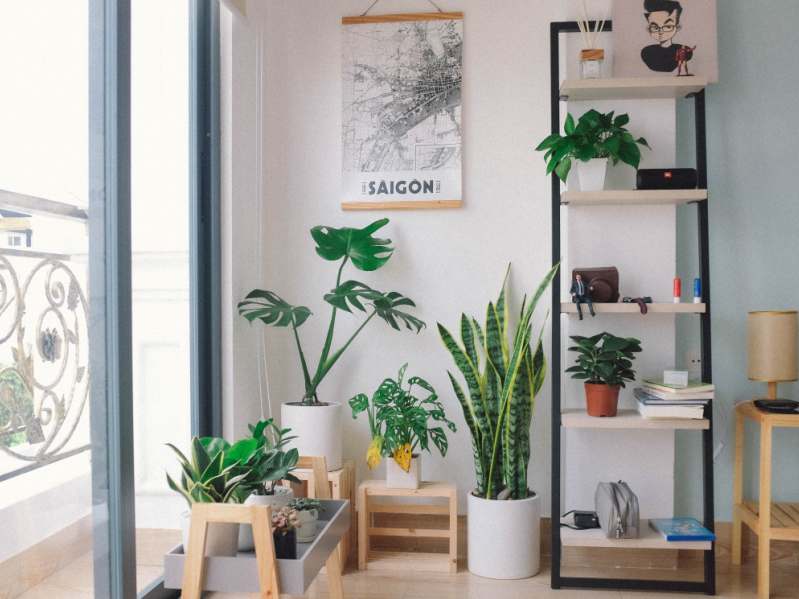
Photo by NeONBRAND on Unsplash
Warm spring weather makes everyone want to head outside for backyard barbeques and time in the pool, but it's also why the plant world starts to bloom again. Trees and flowers begin to bud and bees fly around to pollinate everything. It's pretty to wake up to, but no one enjoys walking around a pollen-coated yard that causes them to sneeze and experience itchy eyes.
While you wait out the pollen indoors, you may notice that you still have some minor allergy symptoms. Even if you never open your windows, indoor air pollutants could float around your home and harm your health.
Check out these eight easy ways to improve the air quality in your home so it's a healthy place to spend your time. You can use these tips all year round to protect yourself and your family.
Mop Your Floors
When you walk inside from getting groceries or walking the dog, you may take your shoes off at the door or track them through your house. They may have mud on their soles, but they're still leaving dirt, dust and pollen behind on your hardwood or linoleum floors.
Invest in a traditional or spray mop so you can clean microscopic pollutants and throw them away. The wet cleaning solution or soapy water will trap anything on your floors and keep them from floating around once you toss them in the trash.
Create a Vacuum Schedule
Everyone stays busy with work, school or family life, so it's easy to forget about vacuuming your home. Create a schedule to remind yourself to vacuum once a day or a couple of times per week. It's a quick solution for dirt or pollen that makes a home in your carpet.
When you walk over the carpet in bare feet, you'll pick up these irritants and leave them behind on your couch or in your bed. Vacuuming takes care of the problem and only requires a few minutes of your time.
Wipe Your Shoes
Another easy solution to indoor air pollutants is to wipe your shoes at your front door. Get a doormat and encourage your family to wipe their shoes on it. They can even leave their shoes in your garage or entryway. They'll leave outdoor pollutants outside so your home is free of anything that could restart your sneezing.
Use a Dehumidifier
Seasonal allergies aren't the only kind of indoor air pollutants that cause problems. Mold is also an issue for many households. It can grow in your carpet, on your windows or behind your walls. Sometimes it triggers symptoms similar to common allergies and other times it creates an inflammatory response that results in bronchitis, fever, insomnia and nausea.
Fight mold in your home by using a dehumidifier in any rooms you think may have a mold issue. The machine dries the air, which is a key component of defeating mold. It needs a warm, moist place to grow, so a dehumidifier takes care of the problem while you remove the remaining mold with household cleaners.
Ventilate Your Home
When outdoor allergens have passed, it's smart to ventilate your home by opening your windows and screened doors. Even if you don't think any pollutants are hanging around, you could accidentally create more. Contaminants like nail polish and cleaning supplies can pollute the air in your home because they contain chemical ingredients. Ventilation will release those toxins and replace them with fresh air that's better for your body.

Clean Your Ceiling Fans
Ceiling fans help make your home more pleasant during hot days and nights, but when was the last time you cleaned them? Fans circulate air and collect the dust mites and pollutants that float nearby. After a few weeks, it forms a layer of dust on the edges of the fan blades and continues to build unless you wipe your fans down.
The dust on your ceiling fans may not seem like a health danger, but it can cause constant persistent symptoms like runny noses, sneezing and mild congestion. This endangers anyone with asthma or lung disorders, so create a reminder to clean your ceiling fans regularly.
Grow Indoor Plants
Clean air has pure oxygen, so grow indoor plants to add more oxygen to your home. Air-purifying plants absorb airborne toxins and replace them with fresh oxygen, as long as you take care of them. Find an indoor plant you like and research how to care of it so you have gorgeous plants in your home that double as both decor and air purifiers.
Replace Your Air Filters
HVAC air filters need to be replaced at least every two months for the average home. Every time your air conditioner or heating turns on, it pulls air through filters and releases it back through vents. Those filters become clogged and it makes your HVAC unit need more time to regulate your indoor air. It's expensive and leaves pollutants in your air, so replace your filters regularly for better results.
Form New Habits
Anyone can use these tips once or twice to improve their indoor air quality, but pollutants will always find a way back inside. Use these solutions to form new habits and live in a consistently cleaner home. Ventilate every room by opening windows, replacing your air filters and mopping your floors so your family stays healthy while they're inside.
Written by Jennifer Landis
About the Author
Jennifer Landis is a mom, wife, writer, and blogger at Mindfulness Mama. She’s quite fond of peanut butter, distance running, yoga, and drinking as much tea as possible. Find her on Twitter @JenniferELandis.
You may also like
Simple and Natural Ways to Clean Hardwood Flooring
Find Yourself in a Good Place: 4 Benefits of Living in the Suburbs
The Most Effective Steps That Help You Become More Environmentally-Friendly
